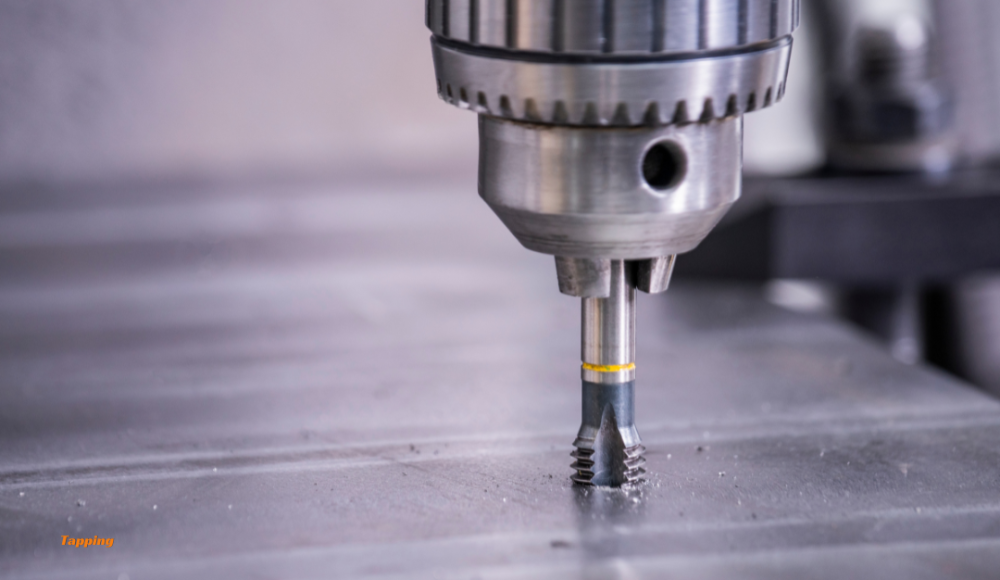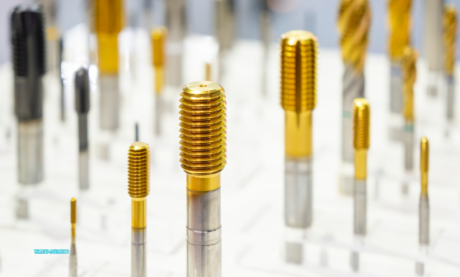Imagínate esto: Se avecina una fecha límite crítica, la pieza perfecta en tus manos, y todo lo que queda es crear esos hilos internos. pero espera, ¿Deberías roscar o roscar?? La elección parece una apuesta en la que hay tiempo y recursos en juego..
No se preocupe: desenredaremos el misterio del fresado de roscas vs.. tocando. Aquí está la verdad sobre lo que aprenderá:
- Los conceptos básicos:Obtenga un resumen rápido del roscado y fresado de roscas.
- Pros y contras:Descubre las fortalezas y debilidades de cada técnica..
- Tiempo de decisión:Aprenda a elegir el método adecuado para su proyecto.
- Factores clave:Le informaremos qué debe considerar antes de comenzar a enhebrar..
Entonces comencemos.
¿Qué es el tapping??
tocando es una técnica probada en el tiempo para crear hilos internos. Piense en ello como si utilizara un tornillo especializado para tallar una ranura coincidente en su pieza de trabajo.. Un grifo es una herramienta de corte cilíndrica con canales en espiral que canalizan el material a medida que gira.. Estas flautas también ayudan a mantener la lubricación y evitar el sobrecalentamiento durante el proceso de roscado..
Tocando en acción: Un desglose paso a paso
- Perforar el agujero piloto:El primer paso es crear un agujero piloto usando una broca con un diámetro ligeramente menor que el tamaño de rosca final deseado.. Este orificio piloto garantiza que el grifo se mantenga centrado y corte roscas limpias..
- tocándolo:Asegure el grifo en su portabrocas y aplique un lubricante o aceite de corte para reducir la fricción y mejorar el flujo de virutas.. Guíe suavemente el grifo directamente hacia el orificio piloto., aplicando una ligera presión cuando comienza a cortar. Es fundamental mantener una alineación escuadrada para evitar que el grifo se rompa..
- retroceder:Una vez que haya alcanzado la profundidad deseada, Invierta la dirección del golpeteo para romper las virutas de metal y lentamente saque el grifo del orificio.. Los golpecitos a menudo crean pequeñas virutas de metal que pueden quedar atrapadas en las roscas.. Invertir el grifo ayuda a eliminar estas virutas y evita que dañen las roscas o emboten la herramienta de corte..
La versatilidad del tapping: El tapping brilla por su capacidad para crear roscas internas en una amplia gama de materiales, desde metales blandos como el aluminio hasta aceros más resistentes. También, Diferentes diseños de grifos le permiten crear varias formas de rosca., como los hilos comunes en forma de V o los hilos cuadrados más especializados.
tocando: Los pros y los contras
Analicemos lo bueno y lo no tan bueno del tapping:
Ventajas
- Demonio de la velocidad:Para las aplicaciones adecuadas, tocar puede ser increíblemente rápido, especialmente en agujeros más pequeños.
- Configuración sencilla:El roscado requiere una preparación mínima y se puede integrar fácilmente en la mayoría de las configuraciones de mecanizado..
- Amplia gama de tamaños de hilo:Tienes muchas opciones, ya que existen varios tamaños de grifos para crear diferentes diámetros y pasos de rosca.
Contras:
- rotura del grifo:Los grifos pueden ser quebradizos, y romper uno dentro de una pieza puede ser un verdadero dolor de cabeza.
- Materiales limitados:El roscado se vuelve más duro en materiales duros como el acero. Es posible que necesites un especialista (y mas caro) grifos para obtener resultados óptimos.
- Una herramienta por tamaño:Necesita un tamaño de hilo diferente? Esto significa un grifo completamente nuevo., Consumiendo tu inventario de herramientas..
Al tocar brilla
Tocar es una excelente opción cuando necesitas rapidez, Roscas internas relativamente económicas en materiales más blandos., especialmente para tamaños de agujeros más pequeños.
¿Qué es el fresado de roscas??
Piense en el fresado de roscas como un escultor de metal.. En lugar de un grifo tallando hilos de una sola pasada, un molino de hilo utiliza un pequeño, herramienta giratoria para fresar gradualmente el material. Esta técnica utiliza una herramienta especializada (una fresadora de roscas) que presenta un perfil de corte que se adapta a la forma de rosca deseada..
Fresado de roscas en movimiento: Un recorrido visual
- taladra ese agujero:como tocar, Comenzarás con un agujero piloto.. Pero el diámetro del agujero al fresar roscas suele ser ligeramente mayor que al roscar.
- Magia helicoidal:El molino de roscar gira a altas velocidades y es guiado con precisión, Camino en espiral dentro del agujero., "tallar" gradualmente los hilos en la pieza de trabajo. Este movimiento helicoidal crea el perfil de la rosca junto con el paso deseado..
- control de programas:El fresado de roscas requiere CNC (control numérico por computadora) tecnología. Las modernas máquinas CNC manejan los movimientos complejos necesarios para una creación de hilos suave y precisa..
La flexibilidad del fresado de roscas: El fresado de roscas no sólo abre la posibilidad de crear roscas en materiales más resistentes, pero también maneja agujeros más grandes con facilidad. Más, Una sola fresadora de roscas puede crear diferentes tamaños y pasos de rosca con solo un cambio en la programación..
Fresado de roscas: Los pros y los contras
Sopesemos las fortalezas y debilidades del fresado de roscas:
Ventajas
- dominio de los materiales:El fresado de roscas es un campeón cuando se trata de materiales resistentes como acero endurecido e incluso aleaciones exóticas..
- Agujeros más grandes, ningún problema:El fresado de hilos facilita la creación de hilos en orificios de mayor diámetro..
- Una herramienta lo hace todo:Una sola fresadora de roscas puede abordar una variedad de tamaños y pasos de rosca: simplemente ajuste el programa CNC.
- Acabado liso:El proceso gradual de eliminación de material a menudo da como resultado resultados más limpios., hilos más suaves que el roscado.
Contras
- Mayor costo:El fresado de roscas suele implicar herramientas más caras y requiere una máquina CNC..
- Configuración más lenta:La programación y configuración del fresado de roscas suele llevar un poco más de tiempo que el sencillo proceso de roscado..
- Control de virutas:El fresado de roscas genera más virutas de metal que el roscado, que requieren buenas estrategias de gestión de chips.
Cuando el fresado de roscas es el camino
El fresado de roscas es ideal para piezas complejas, materiales duros, hilos de gran diámetro, y cuando necesita flexibilidad en los tamaños de hilo que crea.
Cuándo elegir cuál?
El grifo vs.. La decisión de la fábrica de roscas no siempre es clara. Aquí hay un desglose para ayudarlo a tomar la decisión correcta:
Tócalo si...
- La velocidad es crucial:Necesitas crear hilos rápidamente., especialmente en agujeros más pequeños y materiales más blandos.
- El proyecto es simple:Sólo se trata de tamaños de rosca estándar y materiales comunes..
- El presupuesto es una preocupación:Usted está enfocado en mantener bajos los costos.
Hilo, fresarlo si...
- La precisión es clave:Necesita hilos con una precisión excepcional, finalizar, y tolerancias estrictas.
- El material es resistente:Estás trabajando con acero endurecido., titanio, u otros materiales desafiantes.
- Se trata de agujeros más grandes:Su proyecto requiere roscas internas en agujeros de mayor diámetro.
- La flexibilidad es imprescindible:Necesita producir una variedad de tamaños y pasos de rosca..
Factores a considerar
Aquí hay algunas cosas más para considerar al elegir entre roscado y fresado de roscas.:
- Tipo de agujero:¿Es un agujero pasante?, o termina a ciegas? Para agujeros ciegos se prefiere el fresado de roscas..
- Tamaño de la pieza:¿Qué tamaño tiene la pieza de trabajo?? Las piezas más grandes pueden ser más fáciles de manejar con el fresado de roscas.
- Volumen de producción:¿Cuántas piezas roscadas necesitas hacer?? El tapping suele ganar con volúmenes elevados.
- Habilidad y experiencia:¿Tiene las habilidades necesarias de configuración y programación para el fresado de roscas??
Consejo profesional: En muchos casos, una combinación de roscado y fresado de roscas podría ser la solución más eficiente, permitiéndole aprovechar las fortalezas de cada uno.
Tengo hilos? Tienes opciones
Ha dominado los conceptos básicos del roscado y fresado de roscas., y estás listo para hacer esas obras maestras roscadas. Recapitulemos las conclusiones para que puedas abordar tus proyectos como un profesional experimentado.:
- Los grifos son para velocidad.:Configuraciones simples y agujeros más pequeños en materiales más blandos.
- Thread Millers gobierna las cosas difíciles:Materiales endurecidos y agujeros más grandes.
- La flexibilidad es el rey:Los molinos de hilo le brindan espacio para cambiar los tamaños de hilo fácilmente
- Hay una herramienta para cada trabajo:Considere todos los factores antes de elegir
Comprender los pros y los contras del roscado y fresado de roscas le sitúa en el asiento del conductor. Ya sea que esté roscando un simple agujero o roscando la pieza más compleja, la elección está en tus manos. Contáctenos para más información.




